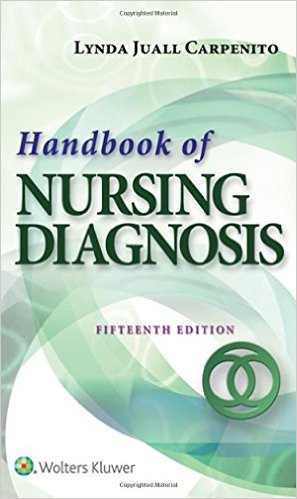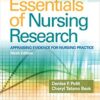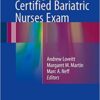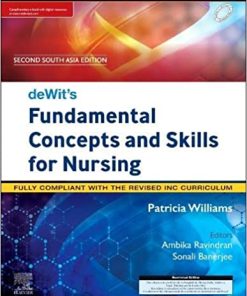- Series: Handbook of Nursing Diagnosis
- Paperback: 960 pages
- Publisher: LWW; 15 edition (July 26, 2016)
- Language: English
- Type : PDF
-
-
Note : We will send ebook download link after confirmation of payment via paypal success
- Payment methods: Visa or master card (Paypal)
-
Handbook of Nursing Diagnosis, 15th Edition
$12
by Lynda Juall Carpenito
- NANDA-I definition
- Defining characteristics (physiologic, emotional and cognitive)
- Related factors including pathophysiologic, treatment related, and situational (personal and environmental)
- Maturational: infant/child, adolescent, adult and older adult
- Errors in Diagnostic Statements
- Key Concepts & General Considerations
- Special Population Consideration (Pediatric, Maternal, Geriatric, and Transcultural)
- Focused Assessment Criteria
- Goals (NIC/NOC) with Rationale
- Interventions for Special Population
Carpenito’s “Handbook of Nursing Diagnosis” is the ideal quick reference for Nursing Diagnosis information. This handbook offers practical guidance on nursing diagnoses and associated care. Compared to Carpenito’s textbook, the handbook is a quick-reference type scope of content, easy for students to use while in clinical, in the classroom or simulation lab. From goals to specific interventions, Handbook of Nursing Diagnosis focuses on nursing. It provides a condensed, organized outline of clinical nursing practice designed to communicate creative clinical nursing. It is not meant to replace nursing textbooks, but rather to provide nurses who work in a variety of settings with the information they need without requiring a time-consuming review of the literature. It will assist students in transferring their theoretical knowledge to clinical practice. This title is intended for nursing students to use through their curriculum.
The 15th edition is organized in three sections. Section 1 provides an alphabetical reference to nursing diagnoses, including NANDA-I definition and Section 2 focuses organizes all the health promotion/wellness nursing diagnoses for individuals. Under each diagnosis, Author’s Notes will elaborate on the clinical usefulness of the diagnosis. Additional foundational knowledge is included in each diagnosis:
Lastly, section 3 covers Diagnostic Clusters, which presents medical conditions with associated collaborative problems and nursing diagnoses, designed for easy reference in the clinical setting.
The handbook differs from the main textbook because it doesn’t go into the foundation for understanding nursing diagnoses, including care planning and concept mapping. The handbook only covers the NANDA-I diagnoses and collaborative problems.
Product Details |
Related Products
MIDWIFERY & NURSING
MIDWIFERY & NURSING
Leadership in Healthcare: Essential Values and Skills, Fourth Edition (EPUB)
MIDWIFERY & NURSING
MIDWIFERY & NURSING
Fundamentals: Perspectives on the Art and Science of Canadian Nursing, 2nd Edition (EPUB)
MIDWIFERY & NURSING
Reflective Practice for Nurses (Student Survival Skills) (Original PDF from Publisher)
MIDWIFERY & NURSING
Reading, Understanding, and Applying Nursing Research, 6th Edition (EPUB)
MIDWIFERY & NURSING
Genetics and Genomics in Nursing and Health Care, 2nd Edition (EPUB)
MIDWIFERY & NURSING
Pflege bei chronisch-entzündlichen Darmerkrankungen (Original PDF from Publisher)
MIDWIFERY & NURSING
Wege in die generalistische Pflegeausbildung (Original PDF from Publisher)
MIDWIFERY & NURSING
Informal Caregivers: From Hidden Heroes to Integral Part of Care (EPUB)
MIDWIFERY & NURSING
Integrating Therapeutic Play Into Nursing and Allied Health Practice (EPUB)
MIDWIFERY & NURSING
MIDWIFERY & NURSING
MIDWIFERY & NURSING
Dimensional Analysis: Calculating Dosages Safely, Third Edition (EPUB + Converted PDF)
MIDWIFERY & NURSING
Writing for Publication in Nursing, 5th Edition (Original PDF from Publisher)
MIDWIFERY & NURSING
Drain’s PeriAnesthesia Nursing: A Critical Care Approach, 8th Edition (EPUB)
MIDWIFERY & NURSING
Oxford Handbook of Perioperative Practice, 2nd Edition (Original PDF from Publisher)
MIDWIFERY & NURSING
MIDWIFERY & NURSING
MIDWIFERY & NURSING
Mastering the Art of Patient Care (Original PDF from Publisher)
MIDWIFERY & NURSING
Mental Health Nursing, 6th Edition (Original PDF from Publisher)
MIDWIFERY & NURSING
Fundamentals Success: NCLEX®-Style Q&A Review, 6th Edition (Original PDF from Publisher)
MIDWIFERY & NURSING
Notes in Urgent Care A Course Companion and Practical Guide (Original PDF from Publisher)
MIDWIFERY & NURSING
Bedside Pain Management Interventions, 1st edition (Original PDF from Publisher)
MIDWIFERY & NURSING
Handbook of Medical Law and Ethics for Nurses (Original PDF from Publisher)
MIDWIFERY & NURSING
NCLEX-RN Made Ridiculously Simple, 4th Edition (Original PDF from Publisher)
MIDWIFERY & NURSING
Fiches pratiques IADE: Infirmier anesthésiste, 3e édition (Original PDF from Publisher)
MIDWIFERY & NURSING
Community and Public Health Nursing: Promoting the Public’s Health, 10th Edition (EPUB3)
MIDWIFERY & NURSING
Core Curriculum for Maternal-Newborn Nursing, 6th edition (Original PDF from Publisher)
MIDWIFERY & NURSING
Calculation of Drug Dosages: A Work Text,12th edition (Original PDF from Publisher)
MIDWIFERY & NURSING
Study Guide for Fundamentals of Nursing, 3rd edition (Original PDF from Publisher)
MIDWIFERY & NURSING
Mosby’s Drug Guide for Nursing Students,15th Edition (Original PDF from Publisher)
MIDWIFERY & NURSING
Fundamentals of Nursing, 11th Edition (Original PDF from Publisher)
MIDWIFERY & NURSING
Illustrated Study Guide for the NCLEX-RN® Exam,11th edition (Original PDF from Publisher)
MIDWIFERY & NURSING
Mosby’s Textbook for Nursing Assistants,10th edition 2020 Original PDF
MIDWIFERY & NURSING
Palliative Care Nursing: Caring for Suffering Patients, 2nd Edition 2022 Original PDF
MIDWIFERY & NURSING
Clinical Leadership in Nursing and Healthcare, 3rd Edition 2022 Original PDF
MIDWIFERY & NURSING
MIDWIFERY & NURSING
Study Guide for Maternal Child Nursing Care, 7th edition 2022 Original PDF
MIDWIFERY & NURSING
Nursing: A Concept-Based Approach to Learning, Volume 2, 4th Edition 2022 Original PDF
MIDWIFERY & NURSING
Psychiatric-Mental Health Nursing: From Suffering to Hope, 2nd Edition 2019 Original PDF
MIDWIFERY & NURSING
Nursing: A Concept-Based Approach to Learning, Volume 1, 4th Edition 2022 Original PDF
MIDWIFERY & NURSING
Community Health Nursing: A Canadian Perspective, 5th Edition 2019 Original PDF
MIDWIFERY & NURSING
Burns’ Pediatric Primary Care, 7th Edition 2019 Original PDF
MIDWIFERY & NURSING
Pocket Guide for ECGs Made Easy, 7th edition 2022 Original PDF
MIDWIFERY & NURSING
Psychiatric and Mental Health Nursing: The craft of caring, 3rd Edition 2017 Original PDF
MIDWIFERY & NURSING
Textbook of Mental Health and Psychiatric Nursing 2022 Original PDF







































































































